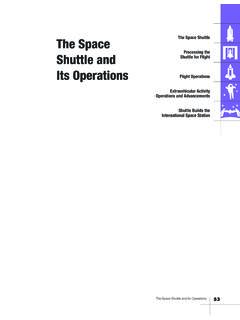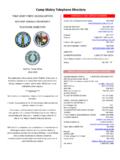Transcription of Build Your Own Robot Arm - NASA
1 Robot Arm Page 1 of 6 Developed by IEEE as part of the IEEE Teacher In-Service Program Build Your Own Robot Arm Part of the IEEE Teacher In-Service Program - Lesson Focus Develop a Robot arm using common materials. Students will explore design, construction, teamwork, and materials selection and use. Lesson Synopsis Participating teams of three or four students are provided with a bag including the materials listed below. Each team must use the materials to design and Build a working Robot arm. The Robot arm must be at least 18 inches in length and be able to pick up an empty Styrofoam cup. Teams of students must agree on a design for the Robot arm and identify what materials will be used. Students will draw a sketch of their agreed upon design prior to construction. Resulting Robot arms are then tested and checked for range of motion and satisfaction of the given criteria.
2 Age Levels 10-18. Objectives Learn design concepts. Learn teamwork. Learn problem solving techniques. Learn about simple machines. Anticipated Learner Outcomes As a result of this activity, students should develop an understanding of: design concepts teamwork needed in the design process impact of technology in manufacturing Lesson Activities Students design and Build a working robotic arm from a set of everyday items with a goal of having the arm be able to pick up a Styrofoam cup. Working in teams of three or four students, the students explore effective teamwork skills while learning simple Robot mechanics. Alignment to Curriculum Frameworks See attached curriculum alignment sheet. Robot Arm Page 2 of 6 Developed by IEEE as part of the IEEE Teacher In-Service Program Resources/Materials 3" wide and approx. 22" long strips of cardboard-- 5 or so Binder clips (different sizes)-- 8 or more Brads-- @10 Clothespins-- 6 Craft sticks--10-15 Fishing line-- 3-4 feet Hangers-- 1 or 2 Paper clips (diff.)
3 Sizes)-- 10-15 Pencils-- 3-4 Rubber bands (different sizes)--15 Tape-- clear and masking (partial rolls should be fine) Twine-- 3-4 feet Various size scraps of cardboard--10 assorted Internet Connections Design Your Own Robot ( ) FIRST Robotics Competition ( ) IEEE Teacher In-Service Program ( ) IEEE Virtual Museum ( ) McREL Compendium of Standards and Benchmarks ( ) A compilation of content standards for K-12 curriculum in both searchable and browsable formats. National Council of Teachers of Mathematics Principals and Standards for School Mathematics ( ) National Science Education Standards ( ) Robot Books ( ) Recommended Reading Artificial intelligence : Robotics and Machine Evolution by David Jefferis (ISBN: 0778700461) Robotics, Mechatronics, and Artificial intelligence : Experimental Circuit Blocks for Designers by Newton C. Braga (ISBN: 0750673893) Robot Builder's Sourcebook : Over 2,500 Sources for Robot Parts by Gordon McComb (ISBN: 0071406859) Robots (Fast Forward) by Mark Bergin (ISBN: 0531146162) Optional Writing Activity Write an essay (or paragraph depending on age) about how the invention of robots and robotics has impacted manufacturing.
4 References Ralph D. Painter and other volunteers - Florida West Coast USA Section of IEEE URL: Robot Arm Page 3 of 6 Developed by IEEE as part of the IEEE Teacher In-Service Program Build Your Own Robot Arm For Teachers: Alignment to Curriculum Frameworks Note: All Lesson Plans in this series are aligned to the National Science Education Standards which were produced by the National Research Council and endorsed by the National Science Teachers Association, and if applicable, also to the International Technology Education Association's Standards for Technological Literacy or the National Council of Teachers of Mathematics' Principals and Standards for School Mathematics. National Science Education Standards Grades 5-8 (ages 10 - 14) CONTENT STANDARD B: Physical Science As a result of their activities, all students should develop an understanding of Motions and forces Transfer of energy National Science Education Standards Grades 9-12 (ages 14 - 18) CONTENT STANDARD B: Physical Science As a result of their activities, all students should develop understanding of Motions and forces Interactions of energy and matter CONTENT STANDARD E: Science and Technology As a result of activities, all students should develop Abilities of technological design Understandings about science and technology Standards for Technological Literacy - All Ages The Nature of Technology Standard 3: Students will develop an understanding of the relationships among technologies and the connections between technology and other fields of study.
5 Technology and Society Standard 7: Students will develop an understanding of the influence of technology on history. Design Standard 9: Students will develop an understanding of engineering design. Standard 10: Students will develop an understanding of the role of troubleshooting, research and development, invention and innovation, and experimentation in problem solving. Abilities for a Technological World Standard 11: Students will develop abilities to apply the design process. The Designed World Standard 19: Students will develop an understanding of and be able to select and use manufacturing technologies. Robot Arm Page 4 of 6 Developed by IEEE as part of the IEEE Teacher In-Service Program Build Your Own Robot Arm For Teachers: Teacher Resources Divide your class into teams of three or four students, and provide student handout (attached).
6 Students are then instructed to examine the materials provided (see list below) and to work as a team to design and Build a Robot arm out of the materials. The Robot arm must be at least 18 inches in length and be able to pick up an empty Styrofoam cup. Teams of students must agree on a design for the Robot arm and identify what materials will be used. Students should draw a sketch of their agreed upon design prior to construction. Explain that teamwork, trial, and error are part of the design process. There is no "right" answer to the problem - each team's creativity will likely generate an arm that is unique from the others designed in your class. Resources/Materials 3" wide and approx. 22" long strips of cardboard-- 5 or so Binder clips (different sizes)-- 8 or more Brads-- @10 Clothespins-- 6 Craft sticks--10-15 Fishing line-- 3-4 feet Hangers-- 1 or 2 Paper clips (diff. Sizes)-- 10-15 Pencils-- 3-4 Rubber bands (different sizes)--15 Tape-- clear and masking (partial rolls should be fine) Twine-- 3-4 feet Various size scraps of cardboard--10 assorted Extension Ideas "Humans and Robots," a NASA educational brief which is attached, describes the robotics features on the International Space Station.
7 The brief's classroom activity is about making and using an ISS grapple fixture known as an end effector. The PDF file is also available at Robot Arm Page 5 of 6 Developed by IEEE as part of the IEEE Teacher In-Service Program Build Your Own Robot Arm Student Handout: How To Build Your Own Robot Arm You are a member of a team of three or four students, all working together to design and Build a Robot arm out of the following materials which are provided to you. The Robot arm must be at least 18 inches in length and be able to pick up an empty Styrofoam cup. Your team must agree on a design for the Robot arm and identify what materials will be used. Your team should draw a sketch of their agreed upon design prior to construction. Part of the teamwork process is sharing ideas and determining which design your team will go with. Trial and error are part of the design process.
8 There is no "right" answer to the problem - your team's creativity will likely generate an arm that is unique from the others designed in your class. Resources/Materials 3" wide and approx. 22" long strips of cardboard-- 5 or so Binder clips (different sizes)-- 8 or more Brads-- @10 Clothespins-- 6 Craft sticks--10-15 Fishing line-- 3-4 feet Hangers-- 1 or 2 Paper clips (diff. Sizes)-- 10-15 Pencils-- 3-4 Rubber bands (different sizes)--15 Tape-- clear and masking (partial rolls should be fine) Twine-- 3-4 feet Various size scraps of cardboard--10 assorted Robot Arm Page 6 of 6 Developed by IEEE as part of the IEEE Teacher In-Service Program Build Your Own Robot Arm Student Handout: Robot Arm Exercise Questions Did you use all the materials provided to you? Why, or why not? Which item was most critical to your Robot arm design?
9 How did working as a team of four help in the design process? Were there any drawbacks to designing as a team? What did you learn from the designs developed by other teams? Name three industries that make use of robots in manufacturing: National Aeronautics andSpace AdministrationEducational ProductEducators Grades 5-12EB-2001-04-004-JSCE ducational BriefHumans and RobotsFollowing the remarkable successes of the ApolloMoon landings and the Skylab space station program,many space experts began reconsidering the role ofhumans in space exploration. In a healthy debate onexploration strategies, some experts concluded the goalsof the future would be best served by robotic space travelers require extensive life supportsystems. With current propulsive technologies, it wouldjust take too long to reach any destination beyond theMoon. Robots could survive long space voyages andaccomplish exploration goals just as well as space experts disagreed.
10 Humans have animportant place in space exploration, they and humans are not interchangeable. Humansare far more adaptable than robots and can react better tothe unexpected. When things go wrong, humans canmake repairs. This, they pointed out, was demonstratedconclusively during Skylab, when spacewalkers maderepairs that saved the , new exploration strategies are at work. Thegoal is no longer humans or robots. It is humans androbots working together. Each bring importantcomplimentary capabilities to the exploration of has been demonstrated time and again with theSpace Shuttle Remote Manipulator System (RMS) robotarm. The arm, also called Canadarm because it wasdesigned and constructed by Canada, has beeninstrumental to the success of numerous space 15-meter-long arm is mounted near the forward endof the port side of the orbiter s payload bay. It has sevendegrees of freedom (DOF). In Robot terms, this meansthat the arm can bend and rotate in seven differentdirections to accomplish its tasks.













